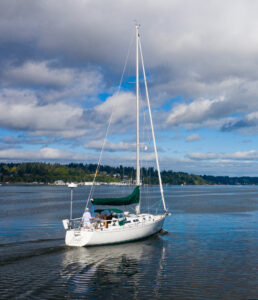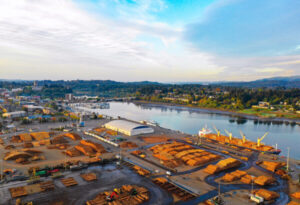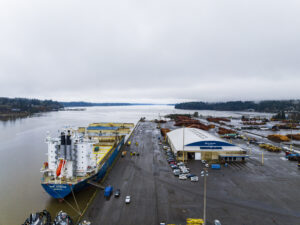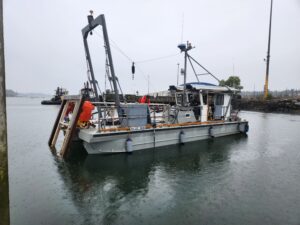Port of Olympia Blog
Welcome to our Environmental Blog Series from Port of Olympia Environmental Manager Jonathon Wolf. This blog series focuses on a variety of environmental topics from Budd Inlet cleanup updates and general education about southern Budd Inlet to other environmental concerns and projects at the Port. Subscribe to receive upcoming posts to your inbox.
 A Highly Toxic Chemical
A Highly Toxic Chemical
Over the past few years, we’ve been learning more about 6PPD-quinone, also known as 6PPDQ, a toxic byproduct of a chemical used to make tires. The chemical is released from the tires during normal wear; when it rains, it is picked up by the water and transported to storm outfalls and into Puget Sound.
Scientists have discovered 6PPDQ to be “highly toxic,” if not deadly, to coho salmon populations and other aquatic organisms. The level of toxicity to humans is still unknown, although it has been detected in human urine.
Tests exist to analyze water samples for 6PPDQ at around one part per trillion (essentially, one drop of water in 20 Olympic-sized swimming pools). However, very little is known about how it transports, its longevity of toxicity and its human health impacts. Fortunately, research is underway to improve our understanding of the toxin and how it affects all forms of life.
 How 6PPDQ Impacts Budd Inlet
How 6PPDQ Impacts Budd Inlet
The Port of Olympia is aware of the potential the hazards of 6PPDQ and its impact on salmon and other aquatic life in Budd Inlet. The Port also recognizes the ecological, commercial and cultural importance of coho salmon to local Tribes and their Treaty Rights.
Like many other organizations, our environmental team is closely following the emerging research about this chemical so that we can do our part to help address harmful impacts and be responsible stewards of the public’s resources. However, 6PPDQ is not the sole responsibility of any one group or organization. It is a widespread problem that will require a coordinated effort to fully address it.
Exploring Possible Solutions
Environmental Protection Agency researchers and partners across the country are working to address these information gaps about 6PPDQ. This information will help the EPA and state, local and Tribal partners make more informed decisions on how best to protect human health and the environment.
The Washington Department of Ecology is actively researching 6PPDQ and options that will help minimize its risk to the environment. Here are a few of the solutions they are exploring:
- One option is to capture and remove the toxin before it has the chance to enter the water. This could include more frequently sweeping streets.
- Another option is to contain contaminated water in stormwater ponds. This would allow the toxin to “settle out” of the water or for the water to be soaked into the ground. This idea is similar to the City of Olympia’s strategy in Yauger Park, a stormwater complex which is designed to intentionally flood. After the storms subside, the water in the pond is gradually released through pipes leading to Black Lake Meadows stormwater complex and then to Percival Creek and Capitol Lake. The water that reaches Budd Inlet and the Salish Sea is cleaner than before.
- A third option is to use physical and chemical treatments. This could include directing runoff through the soil along roadways where it can infiltrate the soil and remain long enough to become non-toxic, rather than having runoff flow directly to a stream.
Learn More in Online Listening Session
The Washington Department of Ecology is offering an online listening session on Jan. 23 at 9:30 a.m. to share their current research on 6PPDQ and the life cycle of used tires. This is an opportunity for Tribes, interested parties, and the public to give input on the report and ask questions. Find more information and register for the event on their website.
Sign Up for Environmental Updates
Sign up to receive our Environmental Blog Series to your inbox. Some of the topics planned for upcoming issues include salmon and shellfish management practices, sea level rise concerns and other environmental issues impacting Budd Inlet and areas in and around the Port of Olympia.
 About Jonathon Wolf
About Jonathon Wolf
Jonathon Wolf is the Environmental Manager at the Port of Olympia and the lead scientist overseeing the Budd Inlet Remediation project. Jonathon has 25 years of environmental management experience including 18 years as Deputy Director of Natural Resources at the Skokomish Indian Tribe and six years at Washington State Department of Fish and Wildlife.







